Data Management and Processing in Seismology: An Application of Big Data Analysis for the Doublet Earthquake of 2021, 03 March, Elassona, Central Greece
Abstract
1. Introduction
2. Data Description
Seismological Data
3. Methods and Processing
Synthetics Seismograms at Regional Distances
4. Results
4.1. Localization Solutions
4.1.1. The ΜL 6.0, Elassona, 3 March 2021 (10:16:08.3 UTC)
4.1.2. The ΜL 5.9, Elassona, 4 March 2021 (18:38:19.1 UTC)
4.2. Moment Tensor Solutions
4.2.1. The Μw 6.3, Elassona, 3 March 2021 (10:16:08.3 UTC)
4.2.2. The Μw 6.2, Elassona, 4 March 2021 (18:38:19.1 UTC)
5. Discussion
6. Conclusions
Author Contributions
Funding
Institutional Review Board Statement
Informed Consent Statement
Data Availability Statement
Acknowledgments
Conflicts of Interest
Appendix A
| Nr | Origin | Location | M0 | Mw | Depth (km) | Plane 1 | Plane 2 | CLVD (%) | Nr of Stations | Quality | |||||||
|---|---|---|---|---|---|---|---|---|---|---|---|---|---|---|---|---|---|
| Date | Time | Lat (°) | Lon (°) | (dyn*cm) | Catalog | MT | Strike (°) | Dip (°) | Rake (°) | Strike (°) | Dip (°) | Rake (°) | |||||
| 1 | 24 December 2021 | 11:41:47 | 39.8131 | 22.0482 | 0.135 × 1023 | 4.1 | 8.2 | 13 | 178 | 55 | −58 | 307 | 40 | −85 | 8 | 5 | A1 |
| 2 | 1 June 2021 | 15:56:14 | 39.8112 | 22.0601 | 9.602 × 1022 | 4.6 | 10.9 | 12 | 130 | 50 | −87 | 300 | 46 | −98 | 12 | 5 | A1 |
| 3 | 21 March 2021 | 17:15:53.4 | 39.7801 | 22.0903 | 0.296 × 1023 | 4.3 | 9.8 | 10 | 176 | 54 | −91 | 357 | 35 | −89 | 10 | 6 | A1 |
| 4 | 15 March 2021 | 15:43:37.0 | 39.7581 | 22.1159 | 7.173 × 1022 | 4.5 | 6.6 | 11 | 126 | 42 | −87 | 301 | 48 | −93 | 5 | 6 | A1 |
| 5 | 13 March 2021 | 15:09:13.3 | 39.8158 | 22.0372 | 0.135 × 1023 | 4.1 | 7.0 | 12 | 123 | 43 | −90 | 304 | 46 | −89 | 12 | 5 | A2 |
| 6 | 12 March 2021 | 12:57:50.6 | 39.8387 | 22.0134 | 1.187 × 1024 | 5.3 | 7.0 | 13 | 153 | 31 | −91 | 334 | 58 | −89 | 7 | 7 | A1 |
| 7 | 11 March 2021 | 14:19:40.4 | 39.7801 | 22.0811 | 0.240 × 1023 | 4.2 | 6.0 | 11 | 130 | 50 | −89 | 309 | 44 | −95 | 10 | 5 | A1 |
| 8 | 6 March 2021 | 19:47:40.2 | 39.8387 | 22.0738 | 0.240 × 1023 | 4.2 | 5.8 | 10 | 178 | 56 | −60 | 312 | 44 | −126 | 13 | 5 | A2 |
| 9 | 6 March 2021 | 16:36:17.8 | 39.6730 | 22.2505 | 0.135 × 1023 | 4.1 | 7.7 | 15 | 110 | 45 | −92 | 313 | 50 | −90 | 11 | 5 | A2 |
| 10 | 5 March 2021 | 10:01:14.8 | 39.7801 | 22.0775 | 0.296 × 1023 | 4.3 | 8.5 | 13 | 130 | 46 | −85 | 300 | 45 | −94 | 7 | 6 | A1 |
| 11 | 5 March 2021 | 09:59:59.2 | 39.8524 | 22.0308 | 0.296 × 1023 | 4.3 | 9.0 | 12 | 115 | 40 | −90 | 315 | 54 | −77 | 7 | 6 | A1 |
| 12 | 4 March 2021 | 20:03:08.8 | 39.7472 | 22.1581 | 0.296 × 1023 | 4.3 | 6.1 | 10 | 175 | 48 | −78 | 337 | 43 | 257 | 7 | 6 | A1 |
| 13 | 4 March 2021 | 19:31:32.2 | 39.8227 | 22.0505 | 0.296 × 1023 | 4.3 | 6.9 | 11 | 135 | 45 | −87 | 320 | 55 | −78 | 5 | 6 | A1 |
| 14 | 4 March 2021 | 19:23:51.0 | 39.8373 | 21.9424 | 8.339 × 1023 | 5.2 | 9.4 | 12 | 120 | 40 | −85 | 295 | 50 | −95 | 3 | 7 | A1 |
| 15 | 4 March 2021 | 18:45:26.7 | 39.8483 | 22.0816 | 0.296 × 1023 | 4.3 | 6.4 | 10 | 130 | 55 | −100 | 290 | 52 | −100 | 10 | 6 | B1 |
| 16 | 4 March 2021 | 18:38:19.1 | 39.7993 | 22.1260 | 2614 × 1025 | 6.2 | 4.8 | 15 | 149 | 46 | −95 | 336 | 44 | −85 | 3 | 7 | A1 |
| 17 | 4 March 2021 | 11:10:08.2 | 39.7417 | 22.0619 | 0.135 × 1023 | 4.1 | 8.0 | 13 | 140 | 56 | −76 | 300 | 46 | −87 | 13 | 7 | A2 |
| 18 | 4 March 2021 | 09:36:15.8 | 39.7911 | 22.1297 | 7.173 × 1022 | 4.5 | 5.6 | 12 | 156 | 44 | −83 | 327 | 46 | −96 | 10 | 6 | A1 |
| 19 | 4 March 2021 | 02:43:38.1 | 39.7362 | 22.2597 | 0.135 × 1023 | 4.1 | 5.2 | 14 | 130 | 46 | −85 | 300 | 45 | −95 | 11 | 7 | A2 |
| 20 | 3 March 2021 | 21:00:54.9 | 39.7563 | 22.1324 | 0.135 × 1023 | 4.1 | 6.2 | 10 | 183 | 55 | −46 | 304 | 53 | −136 | 12 | 5 | A2 |
| 21 | 3 March 2021 | 18:49:49.1 | 39.7394 | 22.1246 | 0.296 × 1023 | 4.3 | 8.8 | 11 | 115 | 40 | −99 | 307 | 50 | −81 | 4 | 5 | A1 |
| 22 | 3 March 2021 | 18:24:08.0 | 39.7316 | 22.1013 | 1.187 × 1024 | 5.3 | 6.4 | 13 | 100 | 41 | −90 | 305 | 51 | −84 | 6 | 6 | A1 |
| 23 | 3 March 2021 | 11:49:03.9 | 39.7037 | 22.2812 | 9.602 × 1022 | 4.6 | 7.6 | 13 | 160 | 29 | −74 | 323 | 62 | −99 | 7 | 7 | A1 |
| 24 | 3 March 2021 | 11:45:45.9 | 39.6996 | 22.2478 | 1.187 × 1024 | 5.3 | 7.1 | 12 | 171 | 51 | −71 | 322 | 42 | −112 | 5 | 7 | A1 |
| 25 | 3 March 2021 | 11:35:57.0 | 39.7000 | 22.2318 | 0.163 × 1024 | 4.8 | 6.4 | 11 | 112 | 45 | −94 | 299 | 50 | −87 | 6 | 7 | A1 |
| 26 | 3 March 2021 | 11:19:02.0 | 39.7458 | 22.2189 | 0.402 × 1023 | 4.0 | 9.4 | 12 | 145 | 50 | −90 | 330 | 43 | −85 | 10 | 5 | B1 |
| 27 | 3 March 2021 | 11:12:22.3 | 39.7755 | 22.2130 | 0.296 × 1023 | 4.3 | 5.8 | 11 | 110 | 55 | −120 | 320 | 55 | −87 | 11 | 5 | A2 |
| 28 | 3 March 2021 | 10:34:08.1 | 39.7270 | 22.2835 | 0.420 × 1024 | 5.0 | 8.0 | 10 | 171 | 46 | −71 | 325 | 47 | −109 | 10 | 7 | B1 |
| 29 | 3 March 2021 | 10:26:18.7 | 39.6703 | 22.2020 | 0.402 × 1023 | 4.0 | 8.1 | 10 | 109 | 60 | −89 | 287 | 30 | −92 | 11 | 4 | A2 |
| 30 | 3 March 2021 3 March 2021 | 10:23:08.5 | 39.6927 | 22.1640 | 0.402 × 1023 | 4.0 | 7.6 | 14 | 126 | 41 | −90 | 306 | 48 | −89 | 13 | 5 | A2 |
| 31 | 3 March 2021 | 10:21:37.2 | 39.7343 | 22.2194 | 7.173 × 1022 | 4.5 | 8.4 | 11 | 138 | 31 | −76 | 301 | 60 | −98 | 10 | 5 | A2 |
| 32 | 3 March 2021 | 10:20:46.5 | 39.6991 | 22.1576 | 2.243 × 1023 | 4.8 | 7.6 | 13 | 140 | 45 | −98 | 313 | 62 | −86 | 5 | 5 | A1 |
| 33 | 3 March 2021 | 10:19:54.5 | 39.7966 | 22.1013 | 1.505 × 1023 | 4.7 | 9.3 | 12 | 151 | 71 | −84 | 315 | 20 | −106 | 6 | 6 | A1 |
| 34 | 3 March 2021 | 10:16:08.3 | 39.7712 | 22.1566 | 3.173 × 1025 | 6.3 | 8.5 | 11 | 177 | 37 | −56 | 317 | 59 | −113 | 5 | 7 | A1 |
References
- Hatzfeld, D.; Ziazia, M.; Kementzetzidou, D.; Hatzidimitriou, P.; Panagiotopoulos, D.; Makropoulos, K. Microseismicity and focal mechanisms at the western termination of the North Anatolian Fault and their implications for continental tectonics. Geophys. J. Int. 1999, 137, 891–908. [Google Scholar] [CrossRef]
- Kahle, H.-G.; Cocard, M.; Pete, Y.; Geiger, A.; Reilinger, R.P.; Barka, A.; Veis, G. GPS-derived strain rate field within the boundary zones of the Eurasian, African and Arabian Plates. J. Geophys. Res. 2000, 105, 23353–23370. [Google Scholar] [CrossRef]
- Caputo, R.; Pavlides, S. Late Cenozoic geodynamic evolution of Thessaly and surroundings (Central-Northern Greece). Tectonophysics 1993, 223, 339–362. [Google Scholar] [CrossRef]
- Emsc-csem.org. Earthquakes—Earthquake today—Latest Earthquakes in the World—EMSC. 2022. Available online: https://www.emsc-csem.org/#2 (accessed on 11 May 2022).
- Lekkas, E.; Agorastos, K.; Mavroulis, S.; Kranis, C.; Skourtsos, E.; Carydis, P.; Thoma, T. The early March 2021 Thessaly earthquake sequence. Newsl. Environ. Disaster Cris. Manag. Strateg. 2021, 22, ISSN 2653–9454. Available online: https://www.researchgate.net/publication/350091329_The_early_March_2021_Thessaly_Greece_earthquake_sequence (accessed on 8 June 2022).
- Zouros, N.; Pavlides, S.; Chatzipetros, A. Recent movement on the Larissa plain neotectonic faults (Thessaly, C. Greece). Water-level fluctuation or tectonic creep. In Proceedings of the ESC XXIV General Assembly, Athens, Greece, 19–24 September 1994; Volume 67. [Google Scholar]
- Soulios, G. Subsidence de terrains alluviaux dans le sud-est de la plaine de Thessalie, Grece. In Engineering Geology and the Environment; Marinos, P.G., Koukis, G.C., Tsiambas, G.C., Stournaras, G.C., Eds.; A.A. Balkema, Brookfield: Rotterdam, The Netherlands, 1997; pp. 1067–1072. [Google Scholar]
- Rapti-Caputo, D.; Caputo, R. Some remarks on the formation of ground fissures in Thessaly, Greece. In Proceedings of the 5th International Symposium on Eastern Mediterranean Geology, Thessaloniki, Greece, 14–20 April 2004; pp. 1016–1019. [Google Scholar]
- Kontogianni, V.; Pytharouli, S.; Stiros, S. Ground subsidence, Quaternary faults and vulnerability of utilities and transportation networks in Thessaly, Greece. Environ. Geol. 2007, 52, 1085–1095. [Google Scholar] [CrossRef]
- Apostolidis, E.; Koukis, G. Engineering-geological conditions of the formations in the Western Thessaly basin, Greece. Cent. Eur. J. Geosci. 2013, 5, 407–422. [Google Scholar] [CrossRef]
- Ilia, I.; Loupasakis, C.; Tsangaratos, P. Assessing ground subsidence phenomena with persistent scatterer interferometry data in western Thessaly, Greece. Bull. Geol. Soc. Greece 2016, 50, 1693–1702. [Google Scholar] [CrossRef]
- Georgoulas, G.; Konstantaras, A.; Katsifarakis, E.; Stylios, C.D.; Maravelakis, E.; Vachtsevanos, G.J. “Seismic-mass” density-based algorithm for spatio-temporal clustering. Expert Syst. Appl. 2013, 40, 4183–4189. [Google Scholar] [CrossRef]
- Konstantaras, A.J.; Katsifarakis, E.; Maravelakis, E.; Skounakis, E.; Kokkinos, E.; Karapidakis, E. Intelligent Spatial-Clustering of Seismicity in the Vicinity of the Hellenic Seismic Arc. Earth Sci. Res. 2012, 1, 1–10. [Google Scholar] [CrossRef]
- Konstantaras, A. Deep Learning and Parallel Processing Spatio-Temporal Clustering Unveil New Ionian Distinct Seismic Zone. Informatics 2020, 7, 39. [Google Scholar] [CrossRef]
- Kagan, Y.Y. 3-D rotation of double-couple earthquake sources. Geophys. J. Int. 1991, 106, 709–716. [Google Scholar] [CrossRef]
- Konstantaras, A.; Vallianatos, F.; Varley, M.R.; Makris, J.P. Soft-Computing Modelling of Seismicity in the Southern Hellenic Arc. IEEE Geosci. Remote Sens. Lett. 2008, 5, 323–327. [Google Scholar] [CrossRef]
- Astiz, L.; Kanamori, H. An earthquake doublet in Ometepec, Guerro, Mexico. Phys. Earth Planet. Inter. 1984, 34, 24–45. [Google Scholar] [CrossRef]
- Poupinet, G.; Ellsworth, W.L.; Frechet, J. Monitoring Velocity Variations in the Crust Using Earthquake Doublets: An Application to the Calaveras Fault, California. J. Geophys. Res. Atmos. 1984, 89, 5719–5731. [Google Scholar] [CrossRef]
- Beroza, G.C.; Spudich, P. Linearized inversion for fault rupture behavior: Application to the 1984 Morgan Hill, California, earthquake. J. Geophys. Res 1988, 93, 6275–6296. [Google Scholar] [CrossRef]
- Felzer, K.R.; Becker, T.W.; Abercrombie, R.E.; Ekström, G.; Rice, J.R. Triggering of the 1999 MW 7.1 Hector Mine earthquake by aftershocks of the 1992 MW 7.3 Landers earthquake. J. Geophys. Res. 2002, 107, 2190. [Google Scholar] [CrossRef]
- Bath, M. Earthquake energy and magnitude. Phys. Chem. Earth 1966, 7, 117–165. [Google Scholar] [CrossRef]
- Richter, C.F. Elementary Seismology; Freeman & Co.: San Francisco, CA, USA, 1958. [Google Scholar]
- Kagan, Y.; Jackson, D. Worldwide doublets of large shallow earthquakes. Bull. Seismol. Soc. Am. 1999, 89, 1147–1155. [Google Scholar] [CrossRef]
- Konstantaras, A.J. Classification of Distinct Seismic Regions and Regional Temporal Modelling of Seismicity in the Vicinity of the Hellenic Seismic Arc. IEEE J. Sel. Top. Appl. Earth Obs. Remote Sens. 2012, 6, 1857–1863. [Google Scholar] [CrossRef]
- Konstantaras, A. Expert knowledge-based algorithm for the dynamic discrimination of interactive natural clusters. Earth Sci. Inform. 2016, 9, 95–100. [Google Scholar] [CrossRef]
- Moshou, A. Strong Earthquake Sequences in Greece during 2008-2014: Moment Tensor Inversions and Fault Plane Discrimination. Open J. Earthq. Res. 2020, 9, 323–348. [Google Scholar] [CrossRef]
- Moshou, A.; Argyrakis, P.; Konstantaras, A.; Daverona, A.-C.; Sagias, N.C. Characteristics of Recent Aftershocks Sequences (2014, 2015, 2018) Derived from New Seismological and Geodetic Data on the Ionian Islands, Greece. Data 2021, 6, 8. [Google Scholar] [CrossRef]
- Bbnet.gein.noa.gr. NOA Seismic Network (HL)—Introduction. 2022. Available online: https://bbnet.gein.noa.gr/HL (accessed on 15 March 2022).
- Geophysics.geo.auth.gr. Τομέας Γεωφυσικής A.Π.Θ. 2022. Available online: http://geophysics.geo.auth.gr (accessed on 15 March 2022).
- Seiscomp.de. Scolv—SeisComP Release Documentation. 2022. Available online: https://www.seiscomp.de/doc/apps/scolv.html (accessed on 15 March 2022).
- Seiscomp.de. 2022. Available online: https://docs.gempa.de/seiscomp3/current/apps/scolv.html (accessed on 25 April 2022).
- Haslinger, F.; Kissling, E.; Ansorge, J.; Hatzfeld, D.; Papadimitriou, E.; Karakostas, V.; Makropoulos, K.; Kahle, H.; Peter, Y. 3D crustal structure from local earthquake tomography around the Gulf of Arta (Ionian region, NW Greece). Tectonophysics 1999, 304, 201–218. [Google Scholar] [CrossRef]
- Kanamori, H. Determination of effective tectonic stress associated with earthquake faulting. The Tottori earthquake of 1943. Phys. Earth Planet. Inter. 1972, 5, 426–434. [Google Scholar] [CrossRef]
- Haskell, N. Total energy and energy spectral density of elastic wave radiation from propagating faults. Bull. Seismol. Soc. Am. 1964, 54, 1811–1841. [Google Scholar] [CrossRef]
- Helmberger, D.V. Theory and application of synthetic seismograms. In Proceedings of the International School of Physics <<Enrico Fermi>>, Course LXXXV. pp. 174–222. 1983. Available online: https://eurekamag.com/research/020/477/020477221.php (accessed on 8 June 2022).
- Langston, C. A body wave inversion of the Koyna, India, earthquake of December 10, 1967, and some implications for body wave focal mechanisms. J. Geophys. Res. 1976, 81, 2517–2529. [Google Scholar] [CrossRef]
- Golub, H.; Van, L.C. Matrix Computations; The Johns Hopkins Univeristy Press: Baltimore, Maryland, 1983; p. 476. [Google Scholar]
- Das, S.; Kostrov, B. Inversion for seismic slip rate history and distribution with stabilizing constraints: Application to the 1986 Andreanof Islands Earthquake. J. Geophys. Res. 1990, 95, 6899. [Google Scholar] [CrossRef]
- Brune, J. Tectonic stress and the spectra of seismic shear waves from earthquakes. J. Geophys. Res. 1970, 75, 4997–5009. [Google Scholar] [CrossRef]
- Langston, C. Source inversion of seismic waveforms: The Koyna, India, earthquakes of 13 September 1967. Bull. Seismol. Soc. Am. 1981, 71, 1–24. [Google Scholar] [CrossRef]
- Langston, C.; Barker, J.; Pavlin, G. Point-source inversion techniques. Phys. Earth Planet. Inter. 1982, 30, 228–241. [Google Scholar] [CrossRef]
- Cotton, F.; Campillo, M. Frequency domain inversion of strong motions: Application to the 1992 Landers earthquake. J. Geophys. Res. Solid Earth 1995, 100, 3961–3975. [Google Scholar] [CrossRef]
- Kiratzi, A.; Sokos, E.; Ganas, A.; Tselentis, A.; Benetatos, C.; Roumelioti, Z.; Serpetsidaki, A.; Andriopoulos, G.; Galanis, O.; Petrou, P. The April 2007 earthquake swarm near Lake Trichonis and implications for active tectonics in western Greece. Tectonophysics 2008, 452, 51–65. [Google Scholar] [CrossRef]
- Usgs.gov. 2022. FPFIT, FPPLOT and FPPAGE; Fortran Computer Programs for Calculating and Displaying Earthquake Fault-plane Solutions | U.S. Geological Survey. Available online: https://www.usgs.gov/publications/fpfit-fpplot-and-fppage-fortran-computer-programs-calculating-and-displaying (accessed on 8 June 2022).
- Hardebeck, J.L.; Shearer, P.M. A New Method for Determining First-Motion Focal Mechanisms. Bull. Seismol. Soc. Am. 2002, 92, 2264–2276. [Google Scholar] [CrossRef]
- Meju, M. Geophysical Data Analysis: Understanding Inverse Problem Theory and Practise; Course Notes Series; Society of Exploration Geophysicists: Houston, TX, USA, 1994; Volume 6. [Google Scholar]
- Aki, K.; Richards, P.G. Quantitative Seismology, 2nd ed.; Freeman: San Francisco, CA, USA, 1980. [Google Scholar]
- Dreger, D. Time—Domain Moment Tensor INVerse Code (TDMT_INV) Version 1.1; Berkley Seismological Laboratory: Berkeley, CA, USA, 2002; p. 18. [Google Scholar]
- Ichinose, G. Source Parameters of Eastern California and Western Nevada Earthquakes from Regional Moment Tensor Inversion. Bull. Seismol. Soc. Am. 2003, 93, 61–84. [Google Scholar] [CrossRef]
- Bouchon, M. A simple method to calculate Green’s functions for elastic layered media. Bull. Seismol. Soc. Am. 1981, 71, 959–971. [Google Scholar] [CrossRef]
- Bouchon, M. A Review of the Discrete Wavenumber Method. Pure Appl. Geophys. 2003, 160, 445–465. [Google Scholar] [CrossRef]
- Bouchon, M.; Aki, K. Discrete wave-number representation of seismic-source wave fields. Bull. Seismol. Soc. Am. 1977, 67, 259–277. [Google Scholar] [CrossRef]
- Bouchon, M. Discrete wave number representation of elastic wave fields in three-space dimensions. J. Geophys. Res. Solid Earth 1979, 84, 3609–3614. [Google Scholar] [CrossRef]
- Athanasiadis, C.; Martin, P.; Spyropoulos, A.; Stratis, I. Scattering relations for point sources: Acoustic and electromagnetic waves. J. Math. Phys. 2002, 43, 5683–5697. [Google Scholar] [CrossRef]
- Athanasiadis, C. On the acoustic scattering amplitude for a multi-layered Scatterer. J. Aust. Math. Soc. Appl. Math. 1998, 39, 431–448. [Google Scholar] [CrossRef][Green Version]
- Herrmann, R.B.; Wang, C.Y. A comparison of synthetic seismograms. Bull. Seismol. Soc. Am. 1985, 75, 41–56. [Google Scholar] [CrossRef]
- Jost, M.; Hermann, R. A student’s Guide to and Review of Moment Tensors. Seismol. Res. Lett. 1989, 60, 37–57. [Google Scholar] [CrossRef]
- Tarantola, A.; Valette, B. Inverse Problems = Quest for Information. J. Geophys. 1982, 50, 159–170. [Google Scholar]
- Tarantola, A.; Valette, B. Generalized Nonlinear Inverse Problems Solved Using the Least Squares Criterion. Rev. Geophys. Space Phys. 1982, 20, 219–232. [Google Scholar] [CrossRef]
- Moser, T.J.; Van Eck, T.; Nolet, G. Hypocenter determination in strongly heterogeneous Earth models using the shortest path method. J. Geophys. Res. 1992, 97, 6563–6572. [Google Scholar] [CrossRef]
- Wittlinger, G.; Herquel, G.; Nakache, T. Earthquake location in strongly heterogenous media. Geophys. J. Int. 2007, 115, 759–777. [Google Scholar] [CrossRef]
- Lomax, A.; Virieux, J.; Volant, P.; Berge-Thierry, C. Probabilistic earthquake location in 3D and layered models: Introduction of a Metropolis-Gibbs method and comparison with linear locations. In Advances in Seismic Event Location; Thurber, C.H., Rabinowitz, N., Eds.; Kluwer: Amsterdam, The Netherlands, 2000; pp. 101–134. [Google Scholar]
- Ammon, C.J.; Randall, G.E.; Zandt, G. On the non-uniqueness of receiver function inversions. J. Geophys. Res. 1990, 95, 15303–15318. [Google Scholar] [CrossRef]
- Kennett, B.N.L. Seismic Wave Propagation in Stratified Media; Cambridge University Press: Cambridge, UK, 1983. [Google Scholar]
- Randal, G.E. Efficient calculation of complete differential seismograms for laterally homogeneous earth models. Geophys. J. Int. 1994, 118, 245–254. [Google Scholar] [CrossRef]
- Konstantinou, K.; Melis, N.; Boukouras, K. Routine Regional Moment Tensor Inversion for Earthquakes in the Greek Region: The National Observatory of Athens (NOA) Database (2001–2006). Seismol. Res. Lett. 2010, 81, 750–760. [Google Scholar] [CrossRef]
- Tolomei, C.; Caputo, R.; Polcari, M.; Famiglietti, N.A.; Maggini, M.; Stramondo, S. The Use of Interferometric Synthetic Aperture Radar for Isolating the Contribution of Major Shocks: The Case of the March 2021 Thessaly, Greece, Seismic Sequence. Geosciences 2021, 11, 191. [Google Scholar] [CrossRef]
- De Novellis, V.; Reale, D.; Adinolfi, G.; Sansosti, E.; Convertito, V. Geodetic Model of the March 2021 Thessaly Seismic Sequence Inferred from Seismological and InSAR Data. Remote Sens. 2021, 13, 3410. [Google Scholar] [CrossRef]
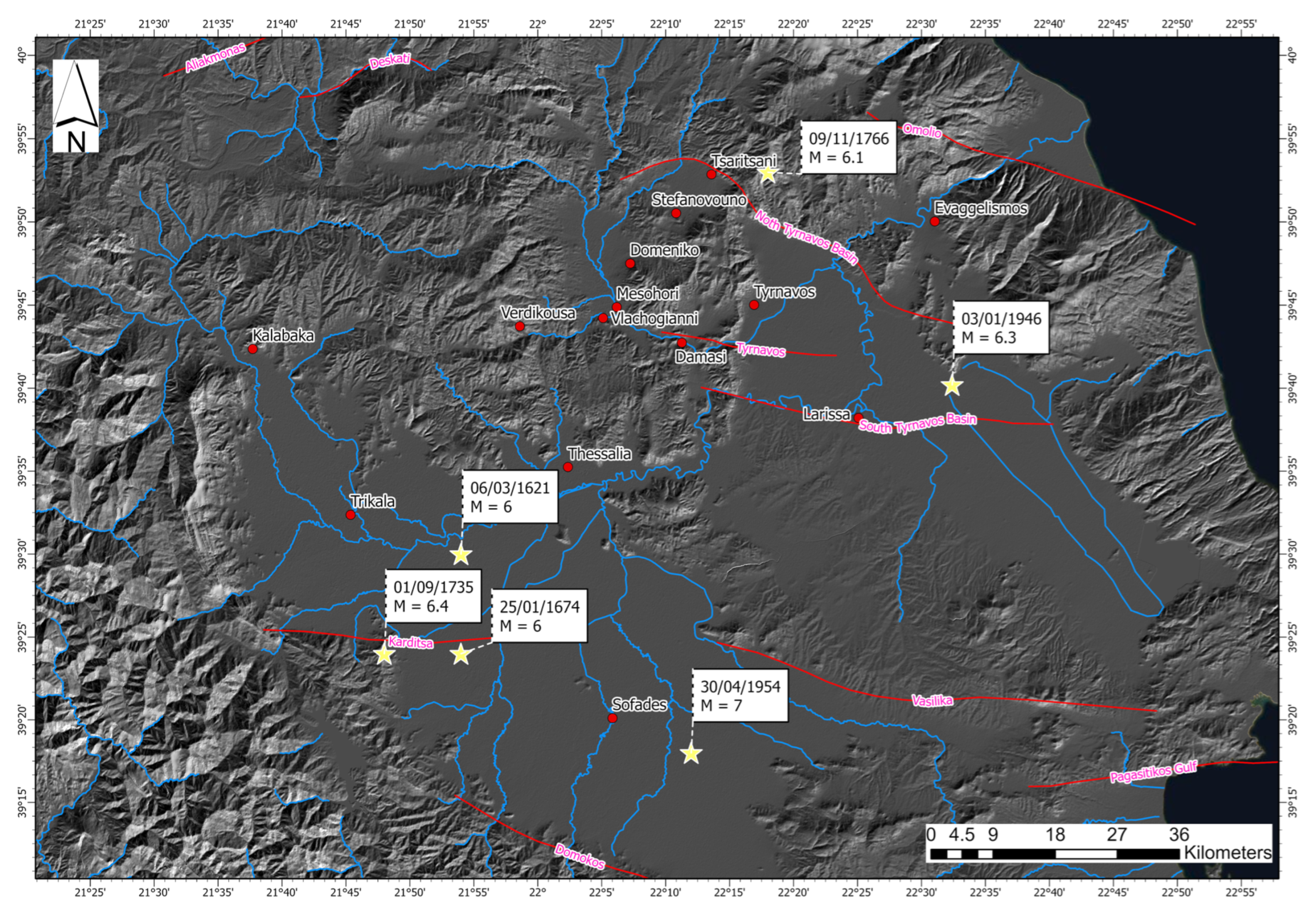
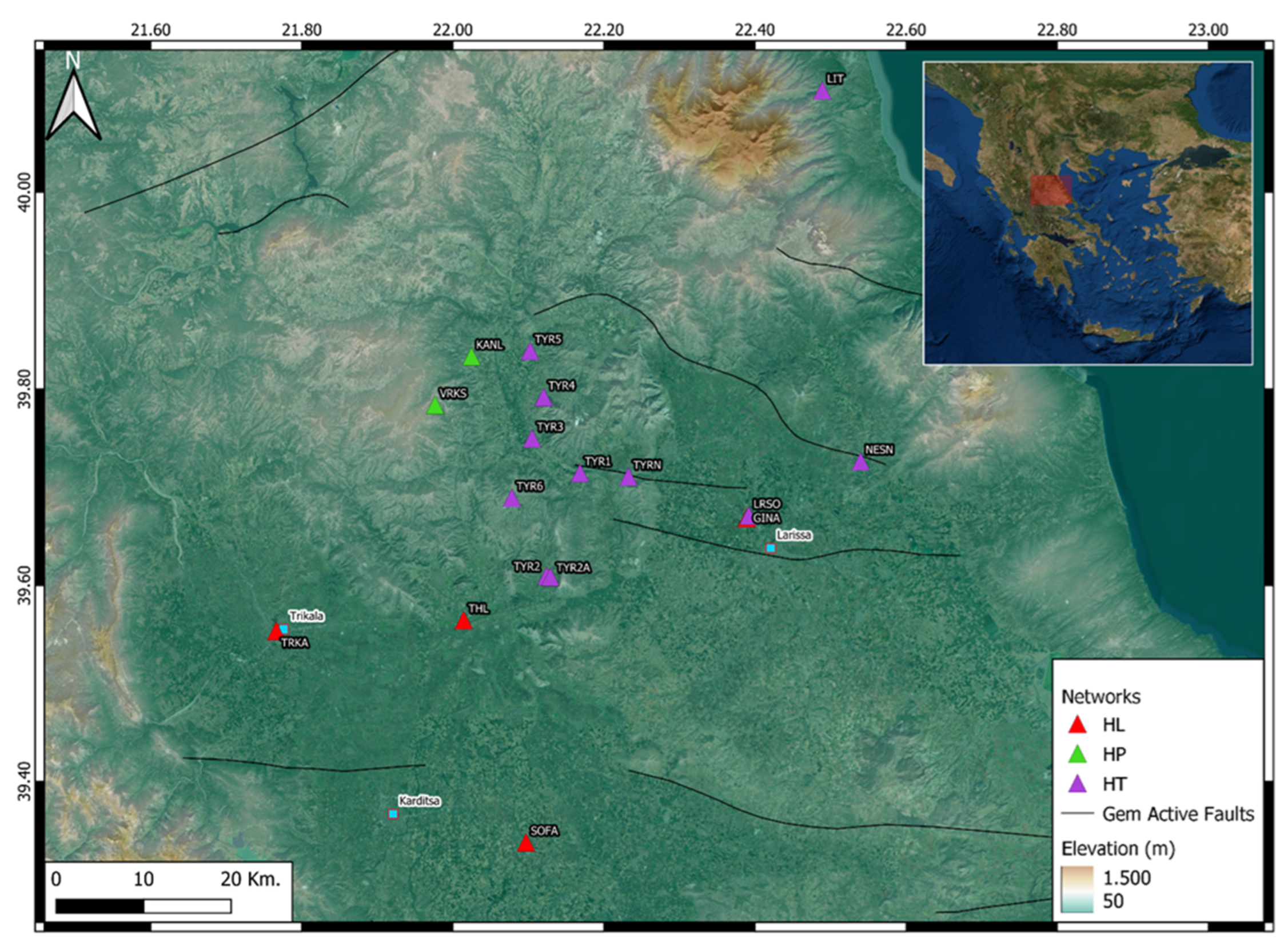
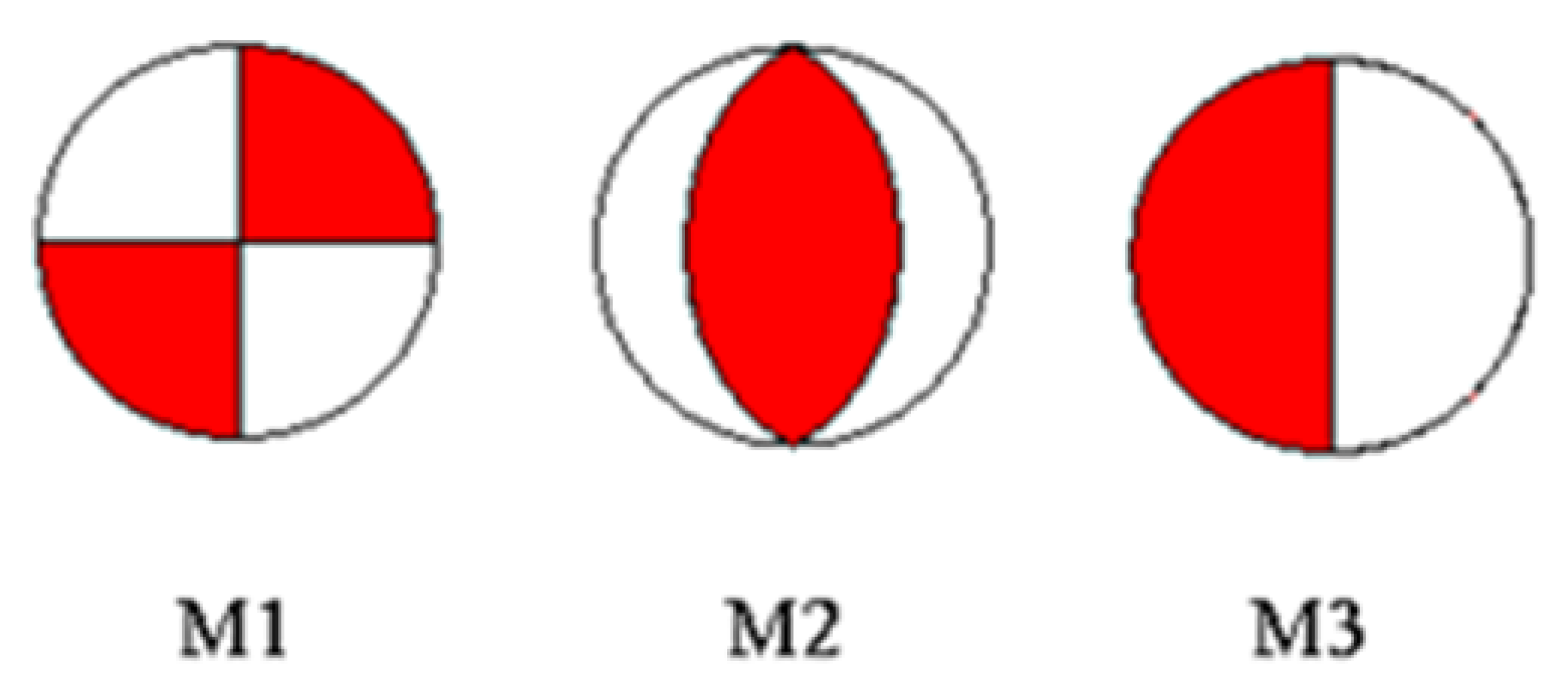
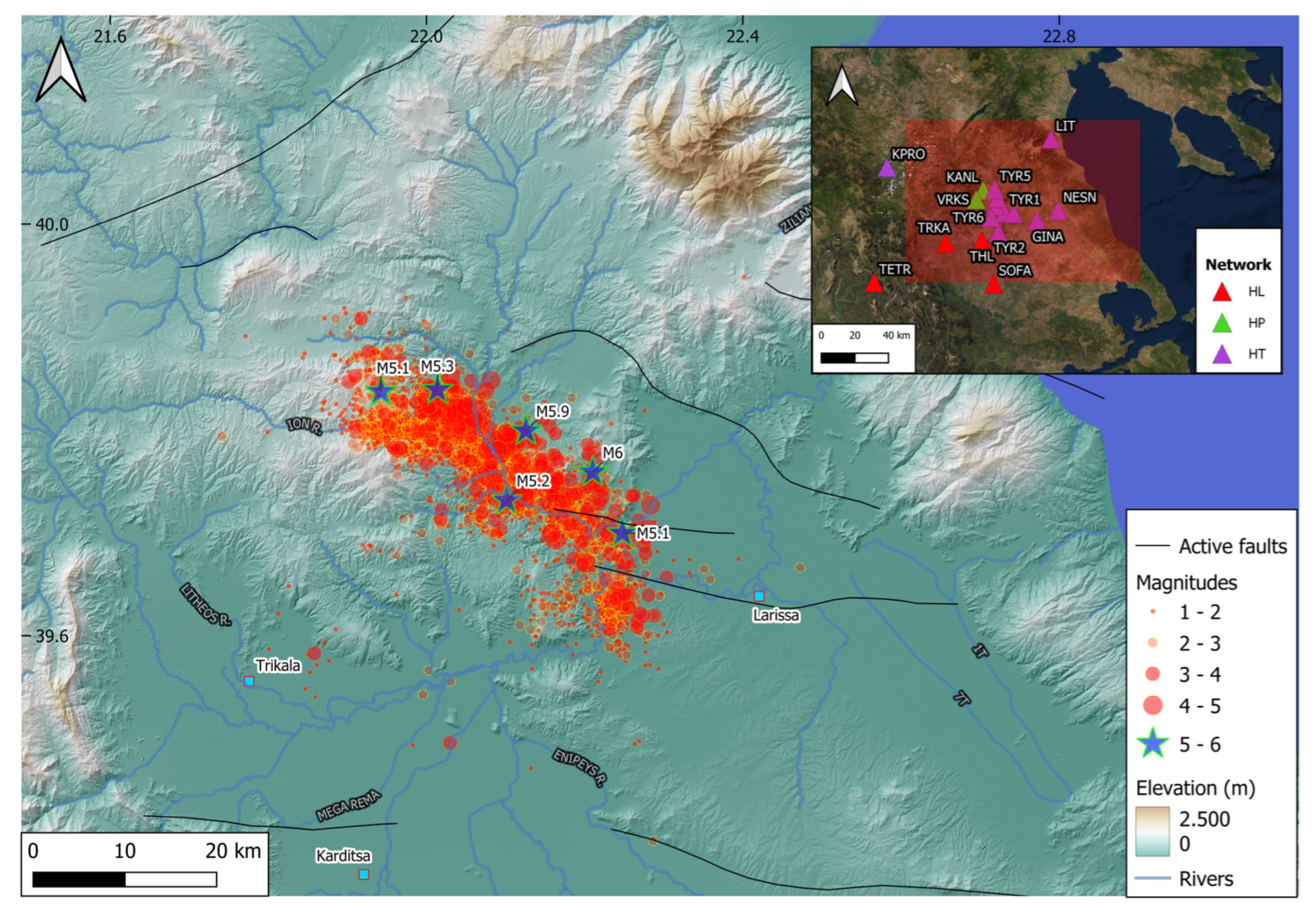


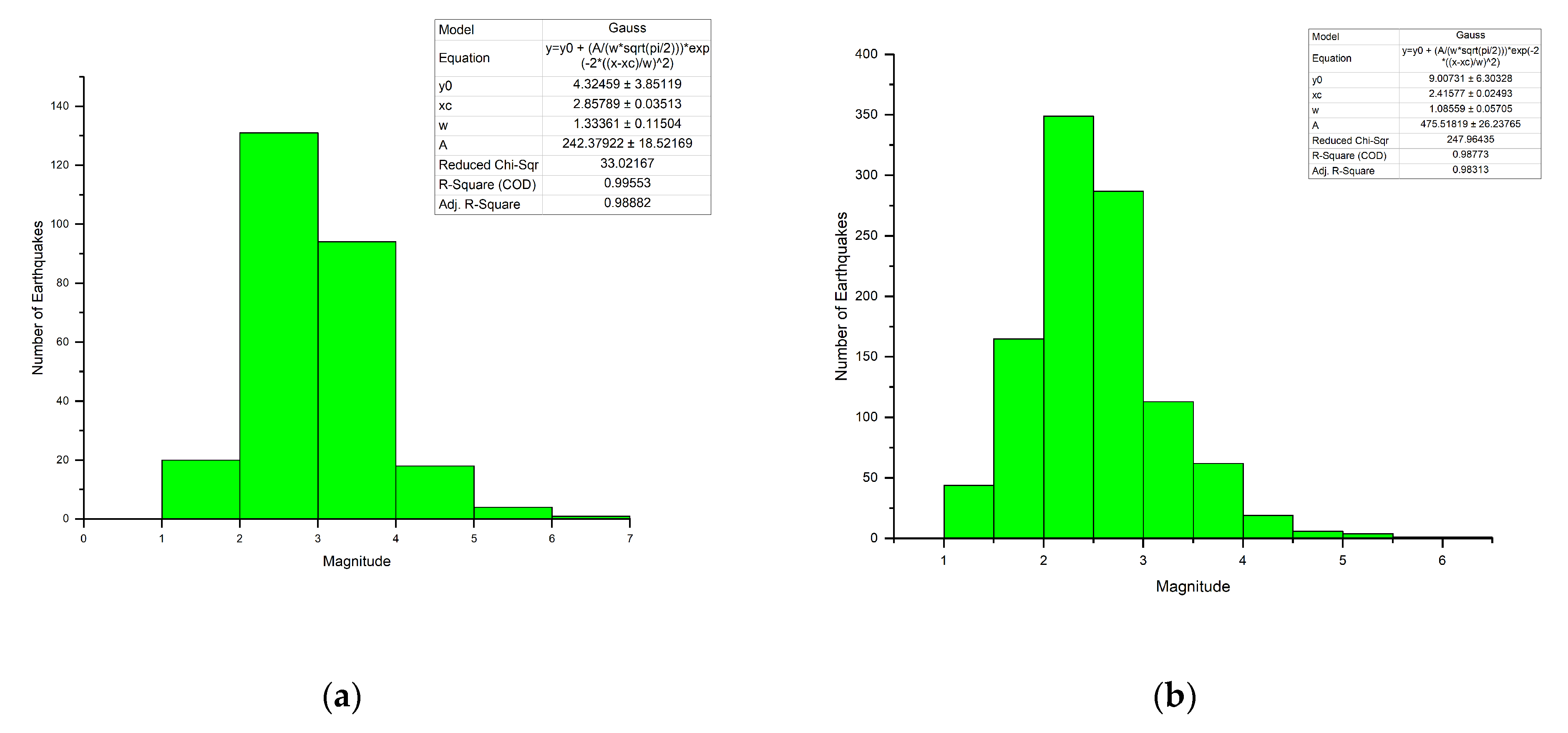

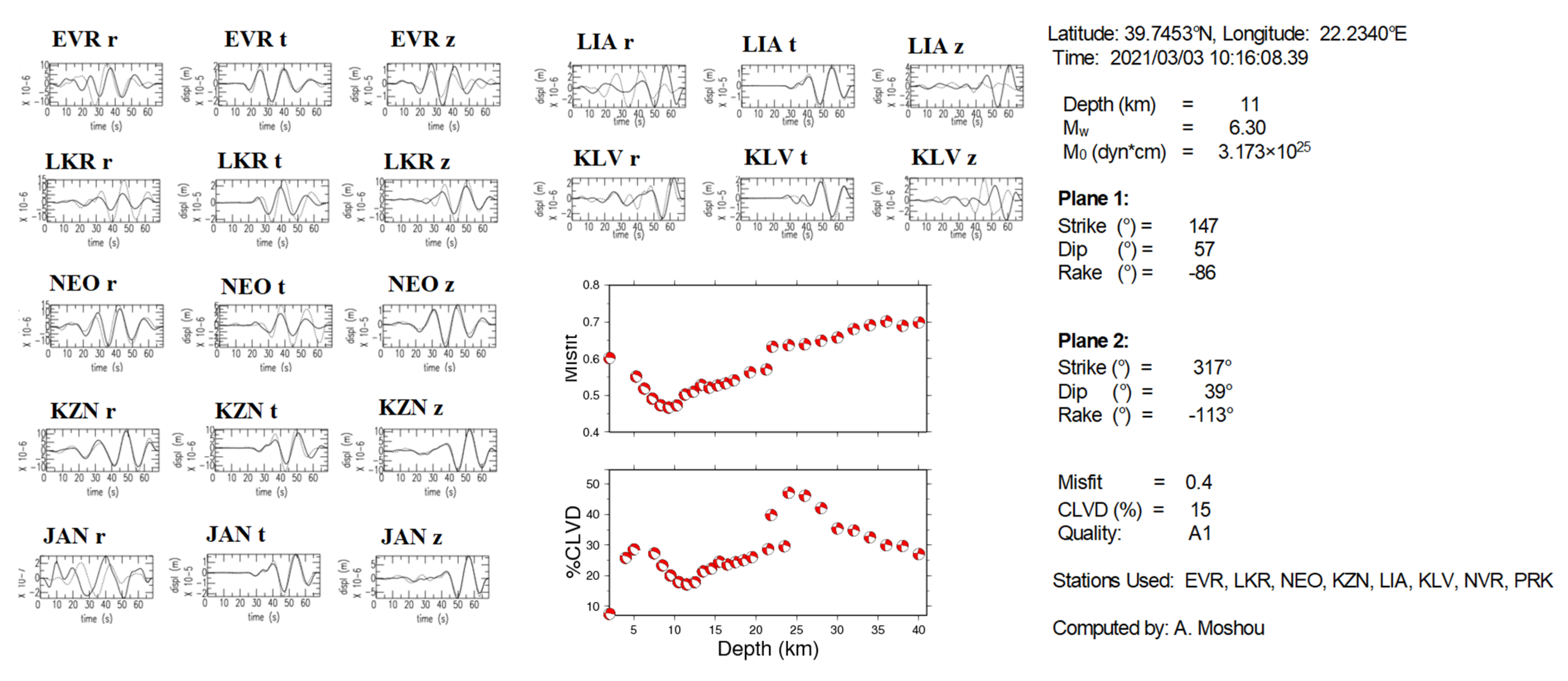
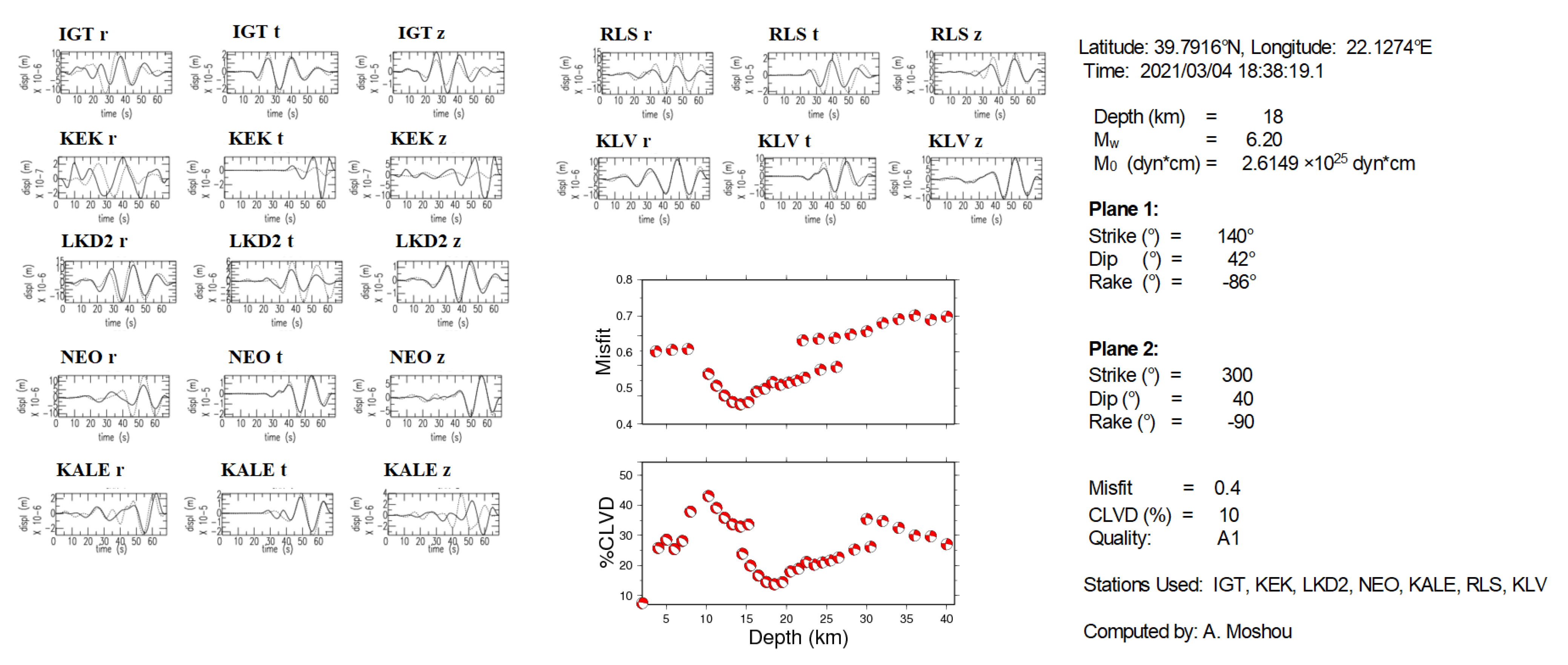
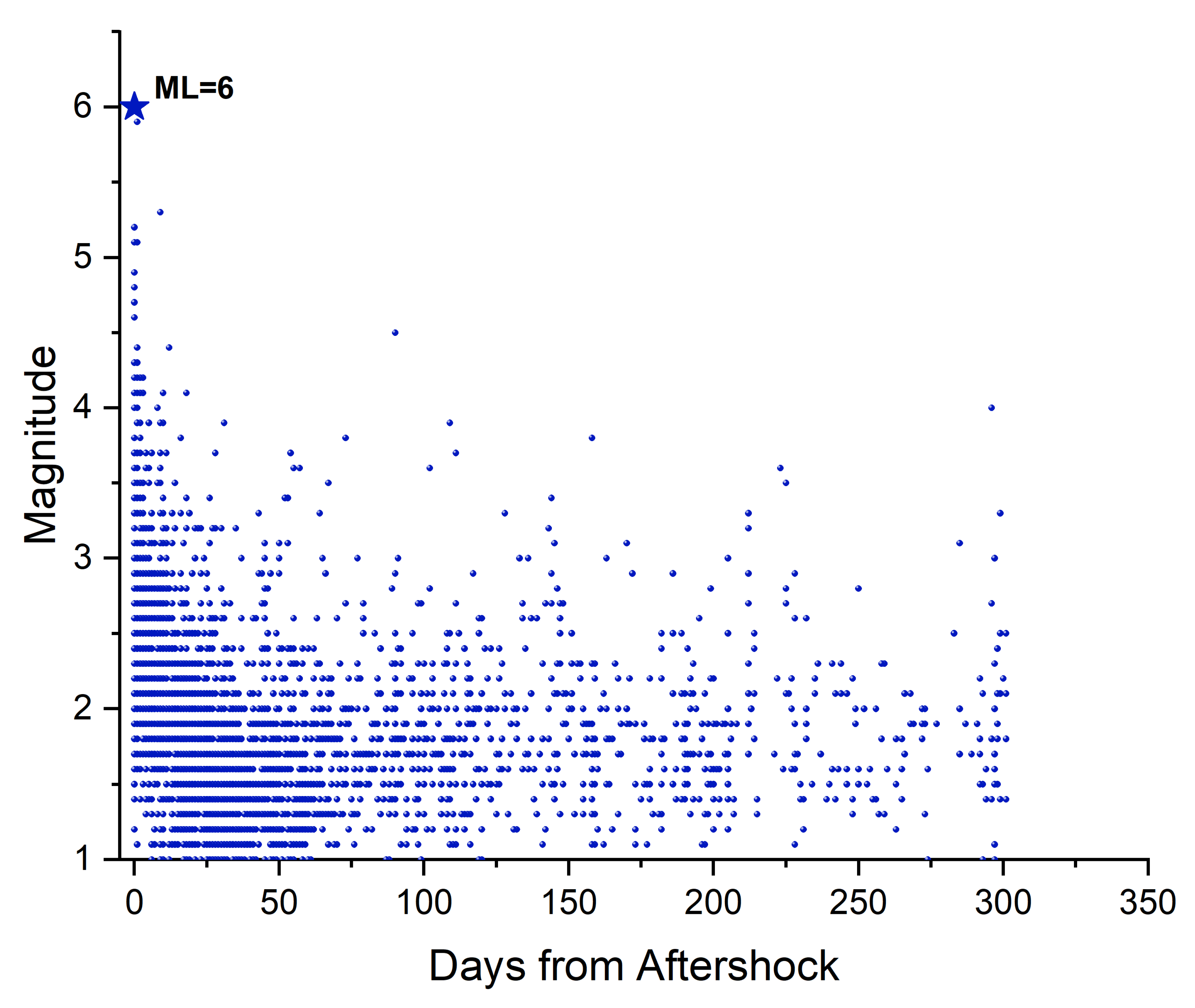
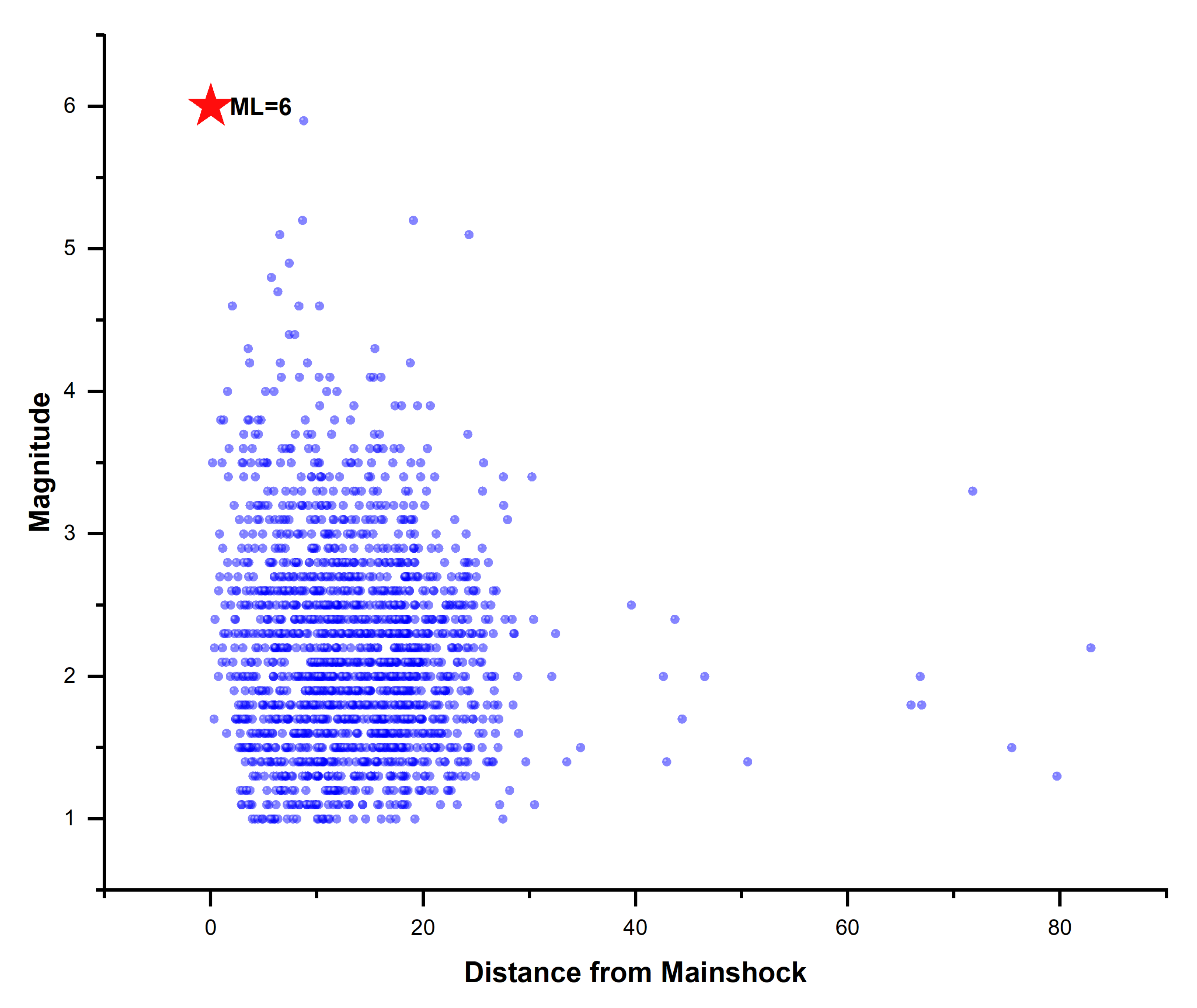
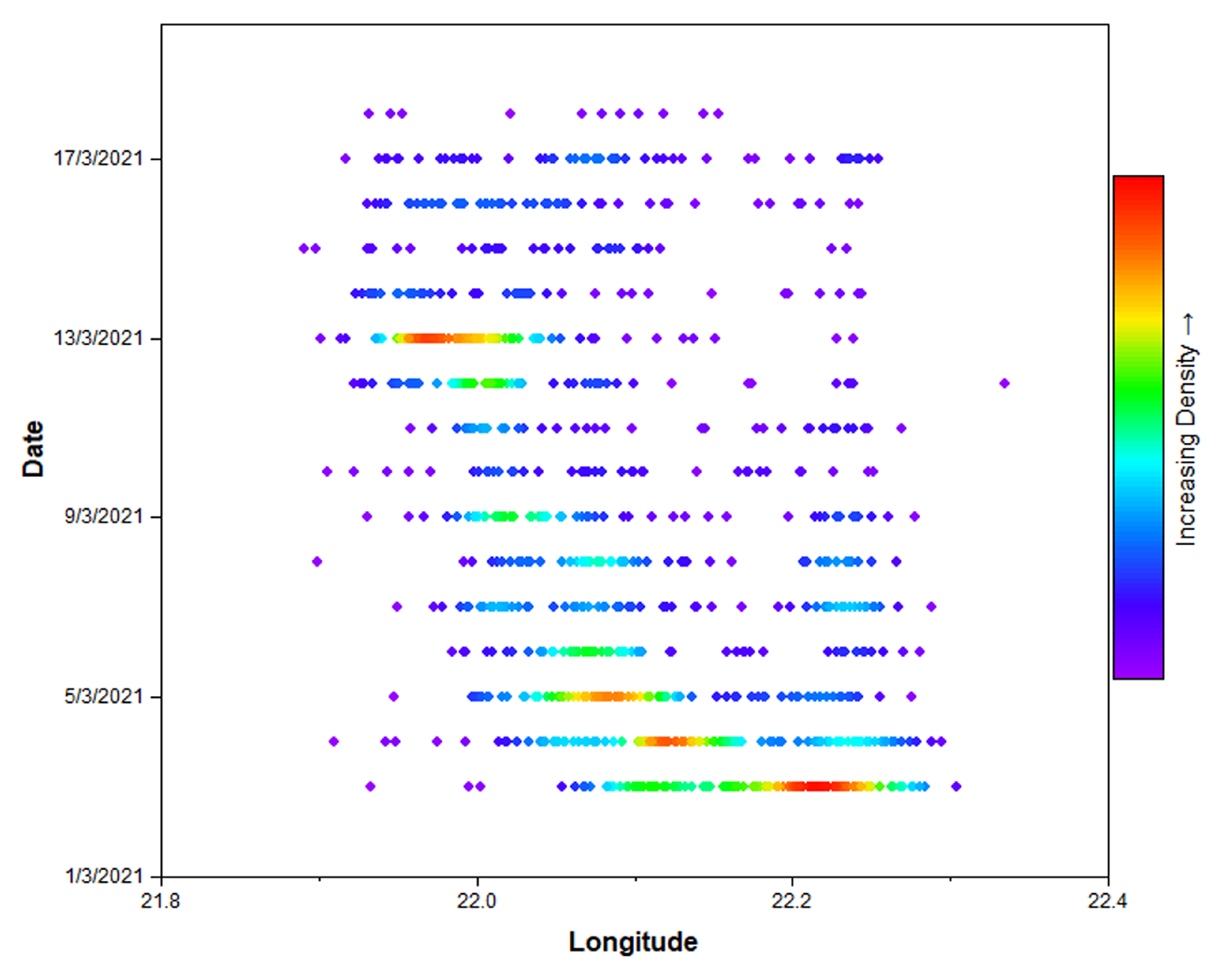
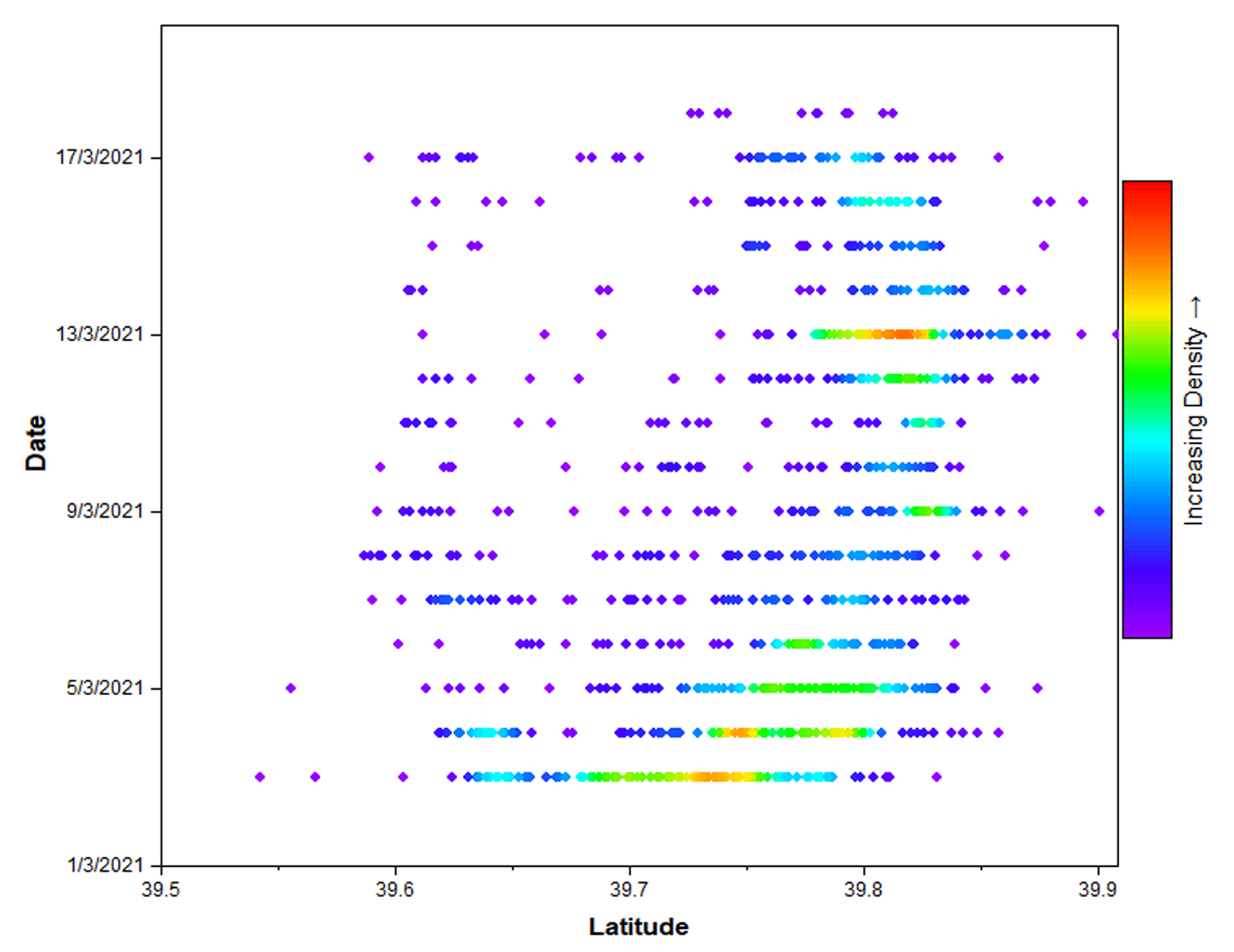
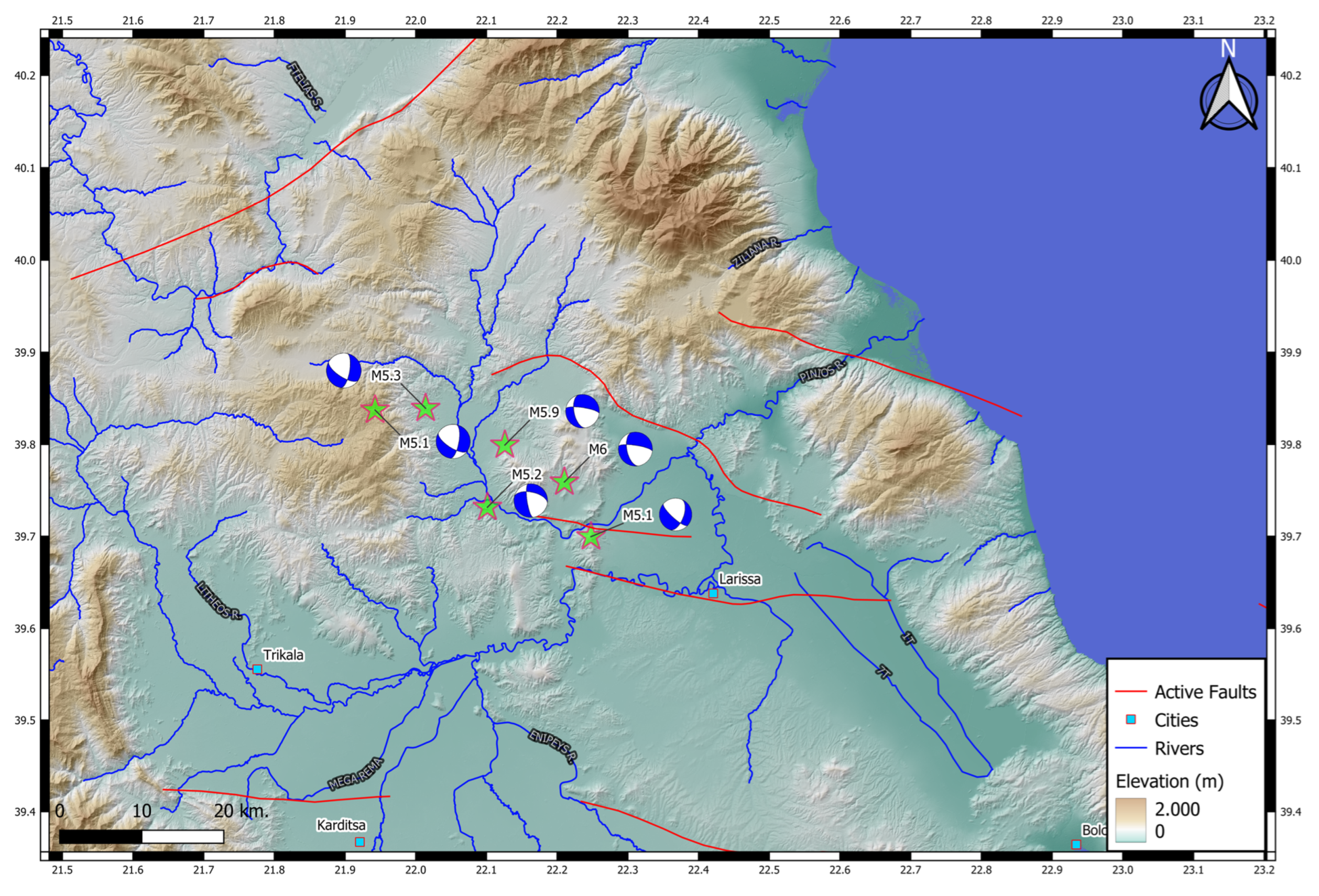
| Stations | Latitude (°) | Longitude (°) | Code | Elevation (m) | Datalogger | Seismometer |
|---|---|---|---|---|---|---|
| THL | 39.5646 | 22.0144 | HL/MN | 86 | DR24-SC | STS-2 |
| KZN | 40.3033 | 21.7820 | HL | 791 | DR24-SC | STS-2 |
| NEO | 39.3056 | 23.2218 | HL | 510 | DR24-SC | KS2000M |
| JAN | 39.6561 | 20.8487 | HL | 526 | DR24-SC | CMG-3ESPC/60 |
| EVR | 38.9165 | 21.8105 | HL | 1037 | DR24-SC | CMG-3ESPC/60 |
| LIT | 40.1003 | 22.4893 | HT | 568 | Trident-B | CMG-3ESP/100 |
| NEO | 39.3056 | 23.2218 | HL | 510 | DR24-SC | KS2000M |
| XOR | 39.3660 | 23.1920 | HT | 500 | TAURUS | CMG-3ESP/100 |
| TYRN | 39.7110 | 22.2325 | HT | 151 | TAURUS | TRILLIUM |
| TYR1 | 39.7147 | 22.1684 | HT | 164 | CENTAUR | TRILLIUM |
| TYR2A | 39.6087 | 22.1291 | HT | 183 | CENTAUR | TRILLIUM Compact |
| TYR3 | 39.7500 | 22.1049 | HT | 209 | CENTAUR | TRILLIUM Compact |
| TYR4 | 39.7919 | 22.1202 | HT | 312 | CENTAUR | TRILLIUM Compact |
| TYR5 | 39.8391 | 22.1023 | HT | 232 | CENTAUR | TRILLIUM Compact |
| TYR6 | 39.6895 | 22.0781 | HT | 462 | CENTAUR | TRILLIUM Compact |
| LRSO | 39.6713 | 22.3917 | HT | 78 | Reftek-130 | CMG-3ESP/100 |
| AGG | 39.0211 | 22.3360 | HT | 622 | CMG-3ESP/100 | CMG-3ESP/100 |
| Elassona Earthquake (3 March 2021, 10:16:08.39, UTC) Mw = 6.3 | |||||||||||
|---|---|---|---|---|---|---|---|---|---|---|---|
| Institute | Latitude (°) | Longitude (°) | Mw | M0 (dyn*cm) | Depth (km) | Strike (°) | Dip (°) | Rake (°) | Strike (°) | Dip (°) | Rake (°) |
| Our Study | 39.7453 | 22.2340 | 6.3 | 3.173 × 1025 | 11.0 | 147 | 57 | −86 | 317 | 39 | −113 |
| USGS | 39.5594 | 21.9200 | 6.3 | 3.330 × 1025 | 11.5 | 139 | 55 | −83 | 307 | 36 | −100 |
| NOA | 39.7545 | 22.1992 | 6.3 | 3.173 × 1025 | 10.0 | 146 | 59 | −79 | 305 | 33 | −108 |
| ERD | 39.8055 | 22.2578 | 6.2 | 2.6149 × 1025 | 7.1 | 147 | 48 | −94 | 332 | 43 | −85 |
| GCMT | 39.6500 | 22.1400 | 6.3 | 3.140 × 1025 | 12.0 | 119 | 45 | −109 | 324 | 48 | −72 |
| INGV | 39.7400 | 22.1900 | 6.2 | 3.600 × 1025 | 10.0 | 116 | 41 | −114 | 327 | 53 | −70 |
| KOERI | 39.7100 | 22.1600 | 6.3 | 2.990 × 1025 | 10.0 | 126 | 37 | −103 | 323 | 53 | −79 |
| GFZ | 39.7700 | 22.1400 | 6.3 | 3.000 × 1025 | 10.0 | 130 | 45 | −90 | 310 | 44 | −89 |
| OCA | 39.7500 | 22.2100 | 6.2 | 3.600 × 1025 | 7.0 | 135 | 45 | −90 | 315 | 45 | −90 |
| IPGP | 39.7640 | 22.1760 | 6.2 | 3.600 × 1025 | 10.0 | 321 | 33 | −78 | 127 | 57 | −98 |
| CPPT | 39.7760 | 22.1800 | 6.3 | 3.400 × 1025 | 12.0 | 125 | 55 | −100 | 321 | 36 | −77 |
| AUTH | 39.7300 | 22.2200 | 6.2 | 2.200 × 1025 | 6.0 | 131 | 54 | −92 | 314 | 36 | −88 |
| UOA | 39.7505 | 22.1980 | 6.3 | 3.120 × 1025 | 19.0 | 130 | 54 | −89 | 309 | 36 | −91 |
| Elassona Earthquake (4 March 2021, 18:38:19.19, UTC) Mw = 6.2 | |||||||||||
| Institute | Latitude (°) | Longitude (°) | Mw | M0 (dyn*cm) | Depth (km) | Strike (°) | Dip (°) | Rake (°) | Strike (°) | Dip (°) | Rake (°) |
| Our Study | 39.7916 | 22.1274 | 6.2 | 2.6149 × 1025 | 18.0 | 140 | 42 | −86 | 300 | 40 | −90 |
| GFZ | 39.8000 | 22.2000 | 6.3 | 3.300 × 1025 | 17.0 | 146 | 48 | −91 | 329 | 41 | −88 |
| NOA | 39.7710 | 22.0958 | 6.0 | 1.364 × 1025 | 11.3 | 112 | 59 | −87 | 287 | 31 | −95 |
| AUTH | 39.7800 | 22.1200 | 5.9 | 9.300 × 1024 | 7.0 | 109 | 60 | −89 | 287 | 30 | −92 |
| UOA | 39.7708 | 22.0918 | 6.1 | 2.0300 × 1025 | 15.0 | 131 | 40 | −88 | 308 | 50 | −92 |
Publisher’s Note: MDPI stays neutral with regard to jurisdictional claims in published maps and institutional affiliations. |
© 2022 by the authors. Licensee MDPI, Basel, Switzerland. This article is an open access article distributed under the terms and conditions of the Creative Commons Attribution (CC BY) license (https://creativecommons.org/licenses/by/4.0/).
Share and Cite
Moshou, A.; Konstantaras, A.; Argyrakis, P.; Petrakis, N.S.; Kapetanakis, T.N.; Vardiambasis, I.O. Data Management and Processing in Seismology: An Application of Big Data Analysis for the Doublet Earthquake of 2021, 03 March, Elassona, Central Greece. Appl. Sci. 2022, 12, 7446. https://doi.org/10.3390/app12157446
Moshou A, Konstantaras A, Argyrakis P, Petrakis NS, Kapetanakis TN, Vardiambasis IO. Data Management and Processing in Seismology: An Application of Big Data Analysis for the Doublet Earthquake of 2021, 03 March, Elassona, Central Greece. Applied Sciences. 2022; 12(15):7446. https://doi.org/10.3390/app12157446
Chicago/Turabian StyleMoshou, Alexandra, Antonios Konstantaras, Panagiotis Argyrakis, Nikolaos S. Petrakis, Theodoros N. Kapetanakis, and Ioannis O. Vardiambasis. 2022. "Data Management and Processing in Seismology: An Application of Big Data Analysis for the Doublet Earthquake of 2021, 03 March, Elassona, Central Greece" Applied Sciences 12, no. 15: 7446. https://doi.org/10.3390/app12157446
APA StyleMoshou, A., Konstantaras, A., Argyrakis, P., Petrakis, N. S., Kapetanakis, T. N., & Vardiambasis, I. O. (2022). Data Management and Processing in Seismology: An Application of Big Data Analysis for the Doublet Earthquake of 2021, 03 March, Elassona, Central Greece. Applied Sciences, 12(15), 7446. https://doi.org/10.3390/app12157446









